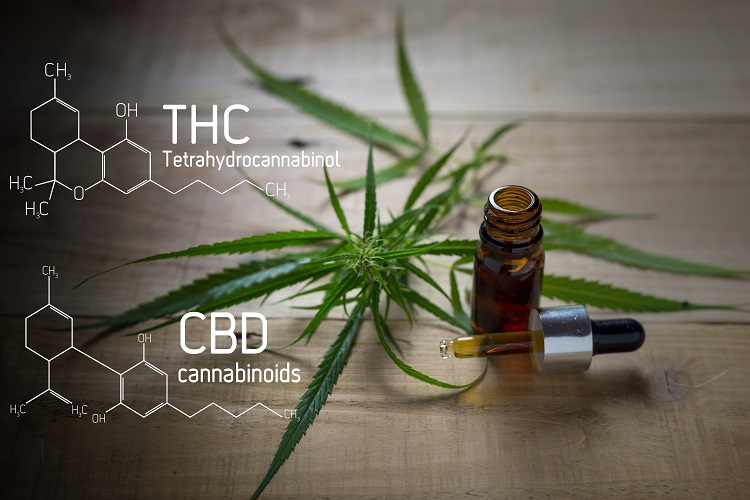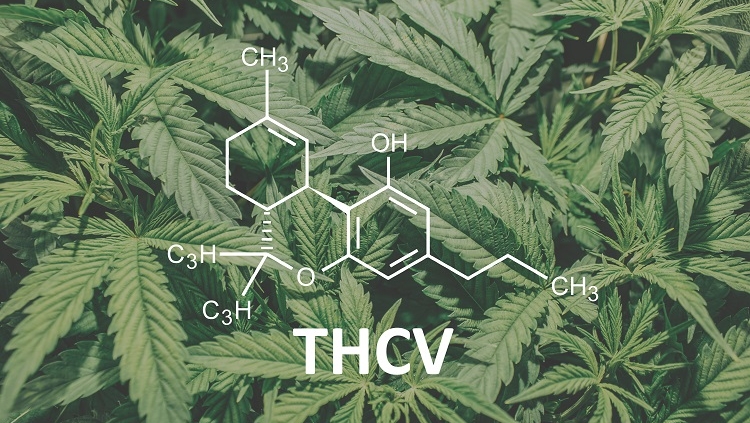What is THCV and what makes it special?
- What is THCV?
- Effects of THCV
- THCV and the endocannabinoid system
- Does THCV have therapeutic potential?
- Can THCV suppress appetite?
- Obesity treatment
- THCV and diabetes: What have the studies found?
- Help with osteoporosis
- Alleviating the symptoms of Parkinson’s disease
- Schizophrenia and the effect of THCV on dopamine
- Conclusion
What is THCV?
Tetrahydrocannabivarin or THCV, is a cannabinoid found in the cannabis plant. Its chemical structure is similar to THC (tetrahydrocannabinol), but it differs in the length of the side chain. THCV has a side chain two carbons shorter than THC. Due to this difference in molecular structure, it has its specific properties and effects. Although THCV was discovered in 1973, it is still nowhere near as popular as some other cannabinoids, such as CBD, CBG, and CBN.
THCV is produced as a by-product of cannabigerovaric acid (CBGVA), which is broken down into tetrahydrocannabivaric acid (THCVA) by an enzyme and finally converted to THCV by the process of decaboxylation (exposure to heat or light). It is reported that the original African sativa strains contain the largest amount of THCV.

Effects of THCV
Unlike THC (delta-9-THC), THCV does not have psychoactive effects when taken in small doses. The experience of some users shows that THCV can increase the feeling of alertness and clarity of mind, but at the same time it can cause some changes in perception. Many people turn to THCV for its relaxing effects. Other reported effects include:
- Improved concentration and productivity
- increase in mental energy (without “mental clouding”)
- slower or faster perception of time
- Different perceptions of sounds, music and colours
- appetite suppression
Some studies suggest a possible therapeutic benefit for these conditions:
- Parkinson’s disease (control of dyskinesia symptoms)
- Inflammatory processes in the body
- Obesity
- Diabetes
- Anxiety, panic attacks
- Osteoporosis (THCV to promote bone growth)
As for side effects, there is not much information available yet. Some users report feeling tired. When taking THCV in high doses, you could experience any of the side effects attributed to THC, such as dry mouth, red eyes, short-term memory impairment, increased heart rate, or paranoia.
Although we are not yet aware of any serious side effects, as with the use of other cannabinoids, caution is advisable, i.e. start with a low dose.
THCV and the endocannabinoid system
Like other compounds from the cannabis plant, THCV interacts with the endocannabinoid system (ECS). This cell signaling system is found in the organism of all mammals. Its main function is to maintain homeostasis – the stability of the internal environment, and to regulate various processes in the body, such as:
- Good appetite
- digestion
- immune response
- memory
- sleep
- mood
The ECS is also involved in maintaining energy homeostasis and regulating lipid and glucose metabolism.
The endocannabinoid system consists of endocannabinoids, enzymes, and cannabinoid receptors, the most well-known of which are CB1 and CB2. CB1 receptors are present primarily in the central nervous system (primarily in the brain), but also in other cells throughout the body, CB2 receptors are mainly found in the immune system and peripheral tissues.
The effects depend on where the receptor is located and what endocannabinoid binds to it. For example, endocannabinoids can block pain signals by targeting CB1 receptors in the spinal cord. Or they can bind to the CB2 receptor in immune cells, in cases where an inflammatory process is taking place in the body. By the way, inflammation is a common symptom of an autoimmune disease.
Studies to date show that THCV binds to CB1 and CB2 receptors with significant potency, although the exact mechanism is still under investigation.
Does THCV have therapeutic potential?
Since the cannabinoid THCV interacts with endocannabinoid receptors in a specific way and at the same time no serious side effects that are common with some drugs have yet been identified, there is a possibility of its therapeutic use. In addition to obesity and diabetes, it could also help with bone disease and in treating or alleviating symptoms of neurodegenerative diseases. Some studies also look at the possibility of using THCV in epilepsy. Let’s now take a look at some of the research in more detail.

Can THCV suppress appetite?
THCV is often mentioned in connection with weight loss, obesity and diabetes treatment. It turns out that unlike THC, which stimulates appetite, THCV has exactly the opposite effect in this regard.
Research confirms that THCV reduces appetite, increases satiety and regulates energy metabolism, making it a clinically useful remedy for weight loss and the treatment of obesity and type 2 diabetes.
Obesity treatment
One of the drugs that was supposed to bring breakthrough and hope in the treatment of obesity was rimonabant. This synthetic drug, approved in Europe in 2006, works by blocking the CB1 receptor – it reduces appetite (hypophagia). Although rimonabant caused a significant reduction in the subjects’ body weight compared to placebo and was shown to be effective in regulating glucose levels and breaking down fatty acids, it had to be withdrawn from the global market in 2008. In addition to nausea and upper respiratory tract infections, it has also been shown to cause serious adverse psychiatric effects, including depression and suicidal thoughts.
And how does it relate to THCV? It turns out that THCV, like rimonabapant, is a selective CB1 receptor antagonist (blocker), but it does not show the same side effects as the drug. Unlike THC, THCV also produces hypophagic effects in both fasting mice and fed mice. This suggests that THCV has great potential for treating obesity.
THCV and diabetes: What have the studies found?
Some studies did not show a significant effect on body weight or food intake, but showed a strong effect on reducing blood glucose and liver triglycerides. Studies conducted on mice have shown that THCV restores insulin sensitivity. For this reason, researchers believe that THCV may be useful in treating metabolic syndrome and type 2 diabetes, either alone or as an adjunctive treatment combined with other therapeutic options.
In another randomized, double-blind, placebo-controlled pilot study, the safety and efficacy of THCV and CBD in patients with type 2 diabetes were evaluated by measuring blood glucose and lipid parameters. Sixty-two volunteers from type 2 diabetes patients not treated with insulin were divided into groups. Some patients took only CBD, others only THCV, and some received both cannabinoids at the same time. The study concluded that the cannabinoids THCV and CBD, administered alone or in combination, are well tolerated in type 2 diabetes. THCV significantly reduced glucose levels, increased beta cell function and adiponectin concentration in patients with type 2 diabetes.
It is therefore clear that THCV can serve as a model for the development of new active substances for glycemic control, especially in type 2 diabetics, as it provides a therapeutic advantage over other cannabinoid analogues in addition to its hypoglycemic and hypolipidemic effects.
Help with osteoporosis
As already mentioned, THCV also binds to the endocannabinoid receptor CB2. This receptor is also found in bones and promotes the formation of new bone tissue. By regulating bone cell activity through the CB2 receptor and at the same time helping to reduce inflammation, THCV offers its use in the treatment of osteoporosis.
A study published in 2012 in the scientific journal Frontiers in Endocrinology, which looked at the role of cannabinoids in bone formation, suggests that THCV and some other cannabinoids stimulate the formation of new bone mass, collagen production and the activity of an enzyme (alkaline phosphatase) in bone marrow cells. However, it is still not known by what mechanisms phytocannabinoids such as THCV regulate bone cell activity.
Alleviating the symptoms of Parkinson’s disease
Cannabinoid-based compounds are showing promise for treating Parkinson’s disease (PD). Blockade of CB1 receptors, which are very abundant in the structures of the basal ganglia, may be effective in reducing the motor inhibition typical of patients with PD.
According to studies to date, the phytocannabinoid THCV appears to have a pharmacological profile that is particularly well suited to patients with PD; it has antioxidant properties and the ability to activate CB2 receptors but also block CB1 receptors, for this reason it could serve to alleviate symptoms and slow or even stop neurodegeneration Although other phytocannabinoids, namely THC and CBD, also exhibit antioxidant properties, THC impairs motor inhibition and CBD, in turn, has only negligible activity at CB1 and CB2 receptors.
A study published in 2011 in the British Journal of Pharmacology suggests that THCV could have the ability to both relieve Parkinson’s symptoms and protect nerve cells (neurons) in a part of the brain called the substantia nigra from dying. It is the loss of neurons that produce the neurotransmitter dopamine that is the cause of Parkinson’s disease.

Schizophrenia and the effect of THCV on dopamine
The 5HT1A receptor is one of many subtypes of serotonin receptors. Activation of 5-HT1A receptors has been shown to increase dopamine release in some parts of the brain (in the prefrontal cortex, striatum, and hippocampus) and may improve symptoms of schizophrenia and Parkinson’s disease.
Research results published in 2014 show that THCV has the ability to interact with 5-HT1A receptors. By affecting the function of the 5HT1A receptor, it can improve a number of neuropsychiatric diseases, such as schizophrenia, anxiety and depression, as well as positively affect cognitive abilities, so THCV could, for example, alleviate learning or memory impairments.
Conclusion
Tetrahydrocannabivarin (THCV) was discovered 50 years ago, yet it has not received as much attention as some other cannabinoids. This may soon change, as several scientific studies have already revealed its potential and possible therapeutic properties in the treatment of obesity, diabetes, osteoporosis and neurodegenerative diseases. However, in order for THCV to be finally approved as a safe substance suitable for the treatment of certain diseases, it is necessary to wait for the conclusions of further research to verify the possible side effects and safety of this cannabinoid.
Resources:
- National Library of Medicine
- Tetrahydrocannabivarin
- The diverse CB1 and CB2 receptor pharmacology of three plant cannabinoids: delta9-tetrahydrocannabinol, cannabidiol and delta9-tetrahydrocannabivarin
- An introduction to the endogenous cannabinoid system
- Are cannabidiol and Δ(9) -tetrahydrocannabivarin negative modulators of the endocannabinoid system? A systematic review
- The diverse CB1 and CB2 receptor pharmacology of three plant cannabinoids: delta9-tetrahydrocannabinol, cannabidiol and delta9-tetrahydrocannabivarin
- The cannabinoid Δ9-tetrahydrocannabivarin (THCV) ameliorates insulin sensitivity in two mouse models of obesity
- Efficacy and Safety of Cannabidiol and Tetrahydrocannabivarin on Glycemic and Lipid Parameters in Patients With Type 2 Diabetes: A Randomized, Double-Blind, Placebo-Controlled, Parallel Group Pilot Study
- Δ9-Tetrahydrocannabivarin (THCV): a commentary on potential therapeutic benefit for the management of obesity and diabetes
- Peripheral cannabinoid receptor, CB2, regulates bone mass
- Efficacy of Phytocannabinoids in Epilepsy Treatment: Novel Approaches and Recent Advances
- Δ⁹-Tetrahydrocannabivarin suppresses in vitro epileptiform and in vivo seizure activity in adult rats
- Frontiers in Endocrinology
- British Journal of Pharmacology
Author: Michaela Mádlová
Photo: Shutterstock
“All information provided on this website, as well as information provided through this website, is for educational purposes only. None of the information contained herein is intended to be a substitute for a medical diagnosis and should not be considered medical advice or recommended treatment. This website does not endorse, condones or advocate the licit or illicit use of narcotic drugs or psychotropic substances or the commission of any other illegal activity. For more information, please see our Disclaimer.”


